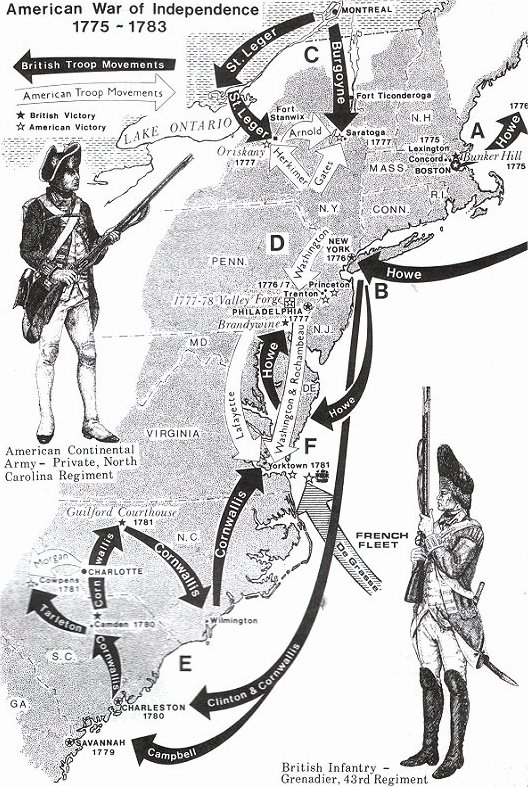

The American War of Independence: Summary
A: BOSTON (April 1775 - March 1776)
1. British troops concentrated in town of Boston under General Gage. British force march to Concord to seize rebel
military stores and clash with American militia at Lexington. On return march from Concord to Boston, the British
troops come under rebel fire.
2. American forces lay siege to Boston and occupy the surrounding hills. Major General Howe leads British attack
to drive Americans from Breed's Hill and Bunker Hill.
3. The American Army forces Howe and British Army to evacuate Boston and move base to Halifax, Nova Scotia.
B: NEW YORK and NEW JERSEY (June 1776 - January 1777)
4. General Howe and British troops sail from Halifax and, after receiving reinforcements, occupy New York.
General Washington and American troops retreat to Pennsylvania.
5. Washington leads American Army into New Jersey and defeats Hessian troops at Trenton. British troops set
out to attack Washington's army, but the Americans avoid them and attack British post at Princeton. British
withdraw to New York.
C: CANADA and SARATOGA (June 1777 - October 1777)
At the beginning of the war, American troops had seized Fort Ticonderoga from the British and then launched an
attack on Montreal and Quebec.
6. General Burgoyne and Lt. Col. St. Leger lead a two-pronged invasion from Canada. Burgoyne attacks Fort
Ticonderoga and St. Leger lays siege to Fort Stanwix. American relief force under Herkimer clash with St.Leger
at Oriskany. St. Leger's force retreats. American troops under Gates and Arnold defeat Burgoyne who surrenders
at Saratoga.
D: PENNSYLVANIA (September 1777 - July 1778)
7. Finding his land route blocked by Washington's army, Howe sails from New York and lands bis army south of
Philadelphia. The British defeat the American defending force at Brandywine Creek and enter Philadelphia.
Washington withdraws his remaining force to Valley Forge where they spend a hard and miserable winter.
When France enters the war, the new British commander, Clinton, evacuates British troops from Philadelphia
and returns to base in New York.
E: SOUTHERN CAMPAIGN (November 1778 - March 1781)
8. Colonel Campbell arrives in Georgia to clear province of rebels. Savannah is unsuccessfully besieged by
combined French and American force.
9. Clinton and Cornwallis sail to South Carolina and force Americans to surrender Charleston. Clinton returns
to New York, leaving Cornwallis to pacify South Carolina. Cornwallis defeats American force under Gates at
Camden.
10. British force under Tarleton attacks Morgan's American troops at Cowpens, but is defeated. Cornwallis
advances into North Carolina and defeats Americans at Guilford Courthouse, but heavy losses force him to retire
to Wilmington to recover.
F: YORKTOWN (May 1781 - October 1781)
American forces lay siege to Boston and occupy the surrounding hills. Major General
Howe leads British attack to drive Americans from Breed's Hill and Bunker Hill.
11. Cornwallis marches northwards to Virginia where he joins with other British forces. Troops
under Lafayette are sent south to aid American forces in Virginia. Unable to
meet Lafayette in battle, Cornwallis moves bis army to Yorktown on the
coast hoping to receive supplies and reinforcements.
12. French Fleet under De Grasse reaches coast of Virginia cutting Cornwallis off
from the sea. (British Fleet fails to defeat De Grasse; returns to New York)
13. Large force of American and French troops under Washington and Rochambeau arrive to close the trap on
Cornwallis. After a 3-week-long siege and heavy bombardment Cornwallis surrenders his army at Yorktown. This
was the last major battle of the American War of Independence. In September 1783 Britain signed a peace
treaty in Paris.
Source: The American Revolution, Tressell Publications, Brighton, GB
|

